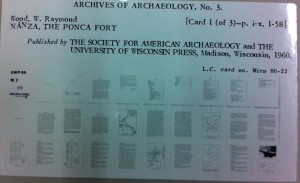 In 1960, at its annual meeting, the Society for American Archaeology authorized the establishment of a new publication series making use of Microcards as the medium of publication. This move toward a condensed, durable, and accessible medium of publishing archaeological data and reports was viewed as a new approach to preservation technology in 1960. The University of Wisconsin was chosen to publish the series and a total of 29 archaeological reports were published on as the Archives of Archaeology series on Microcards between 1960 and 1967. Today, the Archives of Archaeology series has been integrated into tDAR (the Digital Archaeological Record) in keeping with the original publications goals for preservation and access. These 29 archaeological reports, with site locations ranging from Central America to Alaska, are reproduced digitally and in their full form on tDAR. Now these once relatively obscure reports are available for access at any time to any archaeologist with access to the internet.
In 1960, at its annual meeting, the Society for American Archaeology authorized the establishment of a new publication series making use of Microcards as the medium of publication. This move toward a condensed, durable, and accessible medium of publishing archaeological data and reports was viewed as a new approach to preservation technology in 1960. The University of Wisconsin was chosen to publish the series and a total of 29 archaeological reports were published on as the Archives of Archaeology series on Microcards between 1960 and 1967. Today, the Archives of Archaeology series has been integrated into tDAR (the Digital Archaeological Record) in keeping with the original publications goals for preservation and access. These 29 archaeological reports, with site locations ranging from Central America to Alaska, are reproduced digitally and in their full form on tDAR. Now these once relatively obscure reports are available for access at any time to any archaeologist with access to the internet.
These archaeological reports contain data that has never been published before in a widely circulating format. They include early investigations into the effects of climate change on prehistoric peoples in Iowa, full survey reports from the 1959-1962 Southwest Archaeological Expedition of the Chicago Natural History Museum in eastern Arizona, and a first look at English-translated Japanese archaeological reports that are foundational in current understandings of pre-ceramic Japanese occupations. Examine some of the archaeological documents here:
- The 1959-1960 Transwestern Pipeline: Window Rock to Flagstaff
- An Anthropometric and Morphological Analysis of a Prehistoric Skeletal Population from Santa Cruz Island, California
- Archaeological Investigations Near Mobridge, South Dakota
- Archaeological Investigations of Inland and Coastal Sites of the Katamai National Monument, Alaska
- An Archaeological Report on a Cave Deposit (D1-30)
- The Archaeological Sequence form Sipolite, Oaxaca, Mexico
- Artifact Description and Proveniences for the Ringo Site, Southeastern Arizona
- Cachimbos De Alagoinhas
- The Chronological Significance of Maya Ceramics
- Climatic Change and the Mill Creek Culture of Iowa
- Documentation for Prehistoric Investigations in the Upper Little Colorado Drainage, Eastern Arizona
- Documentation for Some Late Mogollon Sites in the Upper Little Colorado Drainage, Eastern Arizona
- Documentation for Chapters in Prehistory of Eastern Arizona, II
- Documentation of Chapters in Prehistory of Eastern Arizona, III
- The Hazzard Collection
- The Hohokam, Sinagua and the Hakataya
- Iown Archaeological Reports 1934 to 1939
- Japanese Source Materials of the Archaeology of the Kurile Islands
- Kamchadal Culture and its Relationships in the Old and New Worlds
- Klamath Basin Petroglyphs
- Na’nza, The Ponca Fort
- Petroglyphs of the Upper Ohio Valley, I
- Pottery and Artifact Provenience Data from Sites in the Painted Rock Reservoir, Western Arizona
- Preceramic Japan: Source Materials
- A Report on a Bluff Shelter in Northeastern Oklahoma (D1-47)
- Salvage Archaeology in Oklahoma: Papers of the Oklahoma Archaeological Salvage Project, Numbers 18-21
- Salvage Archaeology in Oklahoma: Papers of the Oklahoma Archaeological Salvage Project, Numbers 8-15
- Site D1-29, A Rockshelter in Northeastern Oklahoma
- Test Excavations at Maria Camp, British Honduras